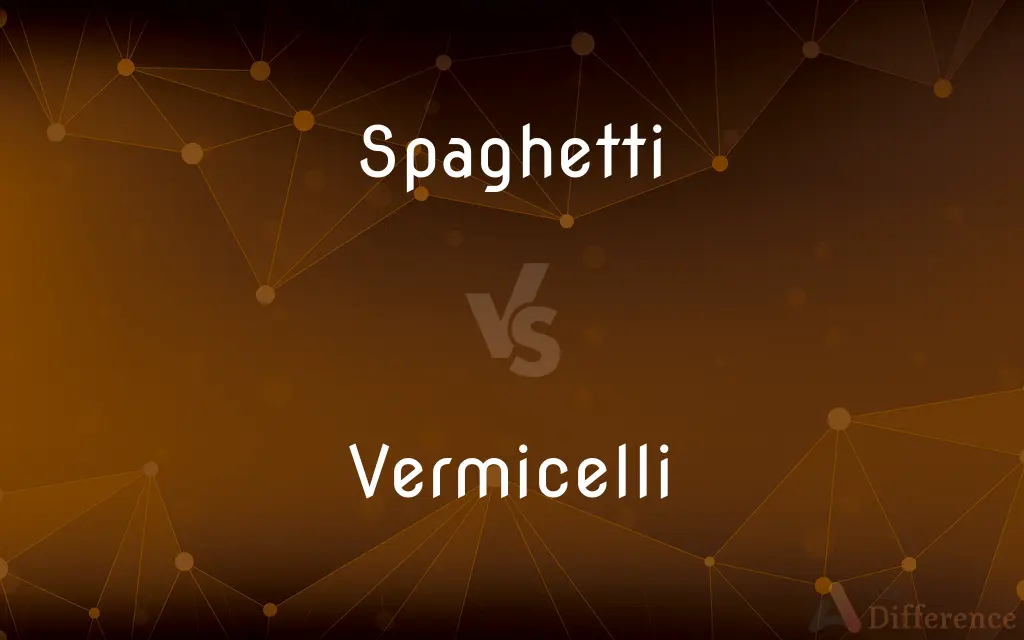Spaghetti vs. Vermicelli — What's the Difference?
By Fiza Rafique & Maham Liaqat — Updated on April 2, 2024
Spaghetti is a long, thin cylindrical pasta of Italian origin, while vermicelli is thinner and can refer to various types of thin pasta or noodles, often used in Asian and Italian cuisines.

Difference Between Spaghetti and Vermicelli
Table of Contents
ADVERTISEMENT
Key Differences
Spaghetti, originating from Italy, is known for its long, thin cylindrical shape and is a staple of traditional Italian cuisine. It is made primarily from durum wheat and water. On the other hand, vermicelli, which means "little worms" in Italian, is even thinner than spaghetti and varies in composition and usage across different cultures. In Italian cuisine, it is made similarly to spaghetti but is thinner, whereas in Asian cuisines, it can be made from rice flour or mung bean starch.
While spaghetti is traditionally served with a wide variety of sauces, from the simple aglio e olio (garlic and oil) to rich meat sauces like Bolognese, vermicelli is used in a broader range of dishes. Italian vermicelli is used similarly to spaghetti but often in lighter dishes. In contrast, Asian varieties serve as the base for both savory dishes, like Vietnamese phở, and sweet dishes, like Indian kheer.
The cooking time for spaghetti and vermicelli differs due to their thickness. Spaghetti generally requires a longer cooking time to reach al dente, or "to the tooth," texture, which is desirable in Italian pasta dishes. Vermicelli, being thinner, cooks more quickly, making it a convenient choice for quick meals and soups.
In terms of nutrition, both spaghetti and vermicelli made from wheat offer similar benefits, including being sources of carbohydrates, fiber, and protein. However, the nutritional content can vary significantly with vermicelli made from alternative ingredients like rice flour or mung beans, often found in gluten-free options.
Spaghetti is typically used in a narrower range of culinary applications, primarily within Italian cuisine, focusing on pairing with various sauces and ingredients. Vermicelli’s thinner texture and different material bases make it a versatile ingredient in a wider array of culinary traditions, from soups and salads to desserts.
ADVERTISEMENT
Comparison Chart
Origin
Italian
Italian, used globally
Thickness
Long, thin, cylindrical
Even thinner than spaghetti, varies by cuisine
Ingredients
Durum wheat and water
Durum wheat, rice flour, or mung bean starch
Dishes
Served with a variety of sauces
Used in savory and sweet dishes, soups, and salads
Cooking Time
Longer due to thickness
Shorter due to being thinner
Nutritional Content
Source of carbohydrates, fiber, protein
Varies, can be gluten-free depending on the ingredient
Culinary Applications
Primarily Italian cuisine
Wide array, including Asian and Italian cuisines
Compare with Definitions
Spaghetti
Often topped with grated cheese, such as Parmesan or Pecorino Romano.
A sprinkle of Parmesan cheese enhances the flavor of spaghetti dishes.
Vermicelli
Can be made from alternative ingredients for gluten-free options.
Mung bean vermicelli is a great gluten-free pasta alternative.
Spaghetti
A type of pasta made from durum wheat and water, formed into long, thin cylindrical strands.
Spaghetti Bolognese is a classic Italian dish.
Vermicelli
A very thin pasta or noodle, varying in material from durum wheat to rice flour.
Rice vermicelli is a key ingredient in many Asian dishes.
Spaghetti
Requires boiling in water until al dente for the best texture.
Perfect spaghetti is often cooked to be firm to the bite.
Vermicelli
In Asian cuisine, it's often used in soups, salads, and stir-fries.
Vermicelli noodles are essential in Vietnamese spring rolls.
Spaghetti
Traditionally served with tomato-based sauces, meat, or vegetables.
Spaghetti with marinara sauce is a simple yet popular meal.
Vermicelli
Versatile in culinary uses, from savory dishes to desserts.
Vermicelli kheer is a popular sweet dessert in Indian cuisine.
Spaghetti
A staple in Italian cuisine, known globally.
Spaghetti dinners are a favorite in households around the world.
Vermicelli
Vermicelli (Italian: [vermiˈtʃɛlli]; lit. 'little worms', , also UK: , ) is a traditional type of pasta round in section similar to spaghetti. In English-speaking regions it is usually thinner than spaghetti, while in Italy it is typically thicker.The term vermicelli is also used to describe various types of thin noodles from Asia.
Spaghetti
Spaghetti (Italian: [spaˈɡetti]) is a long, thin, solid, cylindrical pasta. It is a staple food of traditional Italian cuisine.
Vermicelli
Pasta in the form of long slender threads.
Spaghetti
Pasta made in solid strings, between macaroni and vermicelli in thickness.
Vermicelli
Shreds of chocolate used to decorate cakes or other sweet foods.
Spaghetti
Pasta in long, often thick strands.
Vermicelli
Pasta in long, very thin strands.
Spaghetti
(Electricity) A slender tube of insulating material that covers bare wire.
Vermicelli
Long, slender pasta, similar to spaghetti, only thinner.
Spaghetti
A type of pasta made in the shape of long thin strings.
Vermicelli
Any type of long, thin noodles, as in rice vermicelli.
Spaghetti
(by extension) A dish that has spaghetti as a main part of it, such as spaghetti bolognese.
Vermicelli
(UK) Chocolate sprinkles.
Spaghetti
(informal) Any type of pasta.
Vermicelli
The flour of a hard and small-grained wheat made into dough, and forced through small cylinders or pipes till it takes a slender, wormlike form, whence the Italian name. When the paste is made in larger tubes, it is called macaroni.
Spaghetti
(informal) Electrical insulating tubing.
Vermicelli
Pasta in strings thinner than spaghetti
Spaghetti
(informal) Anything tangled or confusing.
Spaghetti
(countable) A spaghetti western.
Spaghetti
Spaghetti code.
Spaghetti
To become, or appear to become longer and thinner.
The cables spaghettied onto the shoulder of the technician.
Spaghetti
To stretch to become longer and thinner.
He spaghettied the referee when he landed on him.
Spaghetti
A variety or macaroni made in tubes of small diameter.
Spaghetti
Pasta in the form of long strings
Common Curiosities
What's the main difference between spaghetti and vermicelli?
The main difference lies in their thickness, with vermicelli being thinner than spaghetti, and in their global culinary applications.
Are there gluten-free versions of spaghetti and vermicelli?
Yes, there are gluten-free versions made from rice flour, cornflour, or other gluten-free grains.
How should spaghetti and vermicelli be cooked for the best results?
Spaghetti is best cooked to al dente in boiling salted water, whereas vermicelli, especially thinner varieties, require careful monitoring to prevent overcooking.
Do spaghetti and vermicelli have different nutritional values?
Their nutritional values are similar when made from wheat, but vermicelli made from rice or mung beans may have different nutritional profiles, often lower in protein and fiber.
What is spaghetti?
Spaghetti is a long, cylindrical pasta made from durum wheat, notable for its thickness and suitability for hearty sauces.
What distinguishes vermicelli from spaghetti?
Vermicelli is finer and thinner than spaghetti, often used in lighter dishes and in both Italian and Asian cuisines.
Can spaghetti and vermicelli be used interchangeably in recipes?
While they can sometimes be substituted for each other, their differences in thickness and texture may affect the dish's outcome, especially in traditional recipes.
What type of sauces work best with spaghetti?
Thick, hearty sauces like Bolognese or marinara cling well to spaghetti, complementing its robust texture.
Is there a cooking time difference between spaghetti and vermicelli?
Yes, due to its thinner strands, vermicelli typically has a shorter cooking time than spaghetti.
How do I choose between spaghetti and vermicelli for a dish?
Consider the sauce and the dish's overall texture; use spaghetti for thicker sauces and a more substantial texture, and vermicelli for lighter sauces or dishes where a delicate texture is preferred.
How is Asian vermicelli different from Italian vermicelli?
Asian vermicelli is usually made from rice flour or mung bean starch and used in a variety of dishes including soups and stir-fries, while Italian vermicelli is wheat-based and thinner than spaghetti but used in similar contexts.
Share Your Discovery

Previous Comparison
Tripe vs. Trite
Next Comparison
Mule vs. ReverseAuthor Spotlight
Written by
Fiza RafiqueFiza Rafique is a skilled content writer at AskDifference.com, where she meticulously refines and enhances written pieces. Drawing from her vast editorial expertise, Fiza ensures clarity, accuracy, and precision in every article. Passionate about language, she continually seeks to elevate the quality of content for readers worldwide.
Co-written by
Maham Liaqat














































